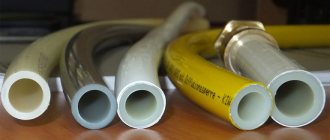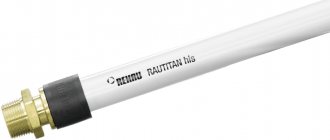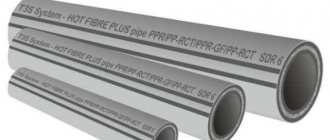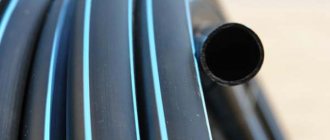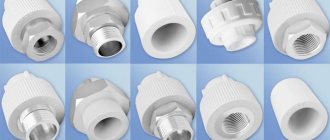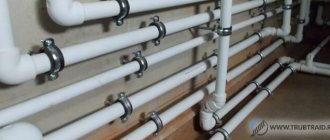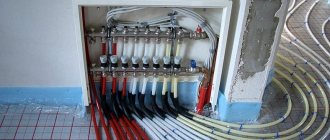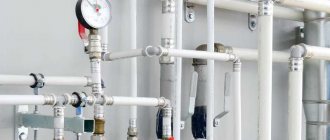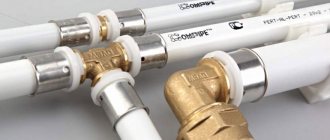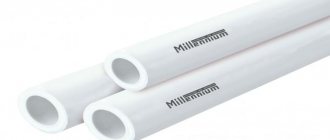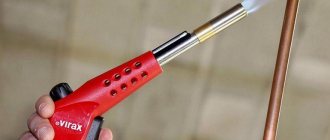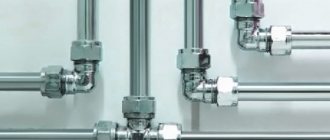Updated: 02/19/2021 18:42:46
Expert: Andrey Nikolaevich Kuznetsov
*Review of the best according to the editors of expertology.ru. About the selection criteria. This material is subjective in nature, does not constitute advertising and does not serve as a purchase guide. Before purchasing, consultation with a specialist is required.
Polypropylene pipes are becoming more and more popular material in the construction industry every year. They are used for installing water supply systems, heating systems, pipelines for pumping aggressive liquids, etc. A distinctive feature of PP pipes is resistance to corrosion, resistance to temperature and pressure changes, and durability. Precipitation does not accumulate on the smooth surface, so there are no problems with pipeline maintenance. To choose the most suitable polypropylene pipes, experts advise paying attention to several parameters.
Manufacturers of quality polypropylene pipes
Often, buyers do not know which polypropylene pipes are needed for heating an apartment, or for laying a water supply system. In order not to make a mistake with your choice, you need to pay attention not only to technical indicators, but also to the manufacturer.
In Russia, plumbing products from the following manufacturers are very popular:
- VALTEC. The Russian-Italian company was opened in 2002 and specialized in the production of pipes and fittings. Today the company produces a large volume of products, and VALTEC pipes have been used in the installation of plumbing systems in some cultural heritage sites;
- Vikma. The company produces many types of engineering plumbing, including pipes for the installation of cold water and hot water systems. The manufacturer checks all products and guarantees that the quality of each pipe and component is 100%. Vikma pipes last for many years and do not require regular repairs;
- Lammin. Russian company producing sanitary ware and accessories. The company has been operating since 1989. During this time, production was expanded. When producing any product - plumbing fixtures, pipes, fittings or radiators, modern developments and only technologically advanced, modern equipment are used.
Plumbing assembly
The method of installing polypropylene pipes is low-temperature soldering. The surfaces of the pipe and fitting are melted upon contact with the Teflon nozzle of the soldering iron and are aligned with each other. Thanks to molecular diffusion, the plastic of the parts is fused into a single whole, and after cooling, the connection is ready for operational loads.
Heating parts with a low-temperature soldering iron
How to solder
How long does it take to heat the pipe and fitting with a soldering iron? Comprehensive instructions are contained in the appendix to SNIP 2.04.01-85, which describes the correct installation of polypropylene.
| Outer diameter of water supply, mm | Heating, sec | Connection time, sec |
| 16 | 5 | 4 |
| 20 | ||
| 25 | 7 | |
| 32 | 8 | 6 |
| 40 | 12 | |
| 50 | 18 |
If you overheat a pipe, the melted plastic will reduce its clearance
Do-it-yourself plumbing soldering has several subtleties.
- When combining a pipe and fitting with a soldering iron nozzle and when connecting parts to each other, they must not be rotated around the longitudinal axis. When turning, waves will remain on the surface of the plastic, which will reduce the quality of the connection, leaving cavities inside the fitting;
- Soldering can begin no less than five minutes after turning on the soldering iron;
- The connection can be subjected to operational loads only after complete cooling (2 minutes for diameters 16-25 mm and 4 minutes for diameters 32-50 mm);
- Polypropylene hot water supply pipes reinforced with aluminum need to be stripped before welding with a fitting. A shaver or trimmer (these tools differ only in the position of the knives) removes the outer or inner layer of foil, allowing welding to combine the fitting with the inner polymer shell of the pipe.
Removing the reinforcing layer using a shaver
Comment: stripping is necessary to ensure that the foil is not destroyed by electrochemical corrosion upon contact with water. This process can lead to delamination of a pipeline section and a catastrophic drop in its tensile strength.
Stripped pipe: the fitting is welded to the inner polypropylene sheath
How to lay
Despite the reinforcement, a long bottling or hot water supply will noticeably change its size with temperature fluctuations.
Here are the features of their installation:
- The turns of the water supply system should not be rigidly fixed: the elbow at the bend acts as an elongation compensator;
Self-compensation of polypropylene hot water supply system
- On long straight sections, expansion joints are welded - bellows, ring or U-shaped;
In the photo - risers for hot water supply and heated towel rails with ring compensators
- The fastening of pipes near expansion joints should be sliding. Fixed fasteners must ensure extension of the water supply section in the direction of the nearest compensator;
- When laying a polypropylene hot water supply pipe in a groove or screed, it is insulated with a material with a low coefficient of friction (usually foamed polyethylene). At pipe bends in the grooves, compensation gaps of about 10 millimeters should be left.
Laying polypropylene in a screed: the pipes are packed in heat-insulating shells made of foamed polyethylene
The best fiberglass reinforced pipes
Fiberglass reinforced pipes are most often used for the installation of heating systems. Such pipes best withstand high pressure and high temperatures and do not deform. The average period of possible use of a polypropylene product is 20-30 years, subject to technical inspections and repair of damaged areas.
Polypropylene pipe POLITEK PRRC PN 20
The POLITEK pipe can withstand a working pressure of 20 bar and is made of fiberglass. The pipe is suitable for installing a water supply system and has a diameter of 25 mm. The maximum possible operating temperature is 90 degrees.
pros
- does not burst if the liquid freezes;
- ease of installation;
- favorable price;
- simple, modern look;
- two layers;
- high-quality reinforcement.
Minuses
- Tee bends may burst; in some cases, their re-installation is required after installing the pipes.
Buyers note that the pipe fully corresponds to the description stated by the manufacturer. It does not burst and is easy to install, has high strength and can serve as a replacement for metal pipes.
2. Pipe VALTEC PP-FIBER PN 20
White polypropylene pipe for installation in water supply systems. The maximum temperature is 90 C. Buyers often purchase pipes from VALTEC - they can be found in many modern apartments. Experts note that these pipes take second place in the quality rating - they are excellent for self-installation.
pros
- elasticity of the material;
- installation without the use of additional equipment;
- strength;
- durability.
Minuses
- high cost compared to other products.
Users are 100% satisfied with the quality of the pipe. It is durable and lightweight, can be installed quickly and does not require repairs over time.
Glass fiber reinforced pipe Lammin 20 mm PP-R PN 20
If you are installing a cold and hot water supply system, you can use a Lammin pipe. The maximum possible temperature is +95 C. Despite the high permissible temperature, it is recommended to put this pipe into operation in systems with average operating temperatures from +20 to +80 degrees. This pipe can also be used to lay a pipe that will be used for household needs, for example, to supply drinking water.
pros
- high quality;
- affordable price;
- durability;
- pressure resistance of 25 bar.
Minuses
- complexity of installation.
According to buyers and craftsmen, pipes from Lammin are among the highest quality. If the installation is performed correctly, you may not need to repair the system for several years.
What about areas of application?
There are other designations as well. Some of them are able to show where and how to install a pipeline from a particular material.
Typically this designation takes the form of a schematic drawing. Marking of reinforced polypropylene pipes is no exception.
The following is a complete list of areas of application.
- For systems providing fire protection.
- In shipbuilding
- For sports facilities.
- To irrigate farmland.
- For use in industrial infrastructure.
- For heating, warm floors and walls.
- In water supply systems.
- With heating pipelines.
- For drinking water pipelines.
Polymers have become especially widespread and have become an integral part of our lives. Labeling of plastic pipes for water supply also cannot be done without them.
The best aluminum reinforced pipes
Pipes, during the manufacture of which an additional thin layer of aluminum was created, can be used in the construction of a heating system in accordance with all standards. Despite the fact that they are universal, it is necessary to select a pipe in diameter and heat resistance based on the specific task.
Reinforced pipe Banninger WATERTEC Stabi
The pipe from Banninger is designed for use in systems in which the water does not heat above 70 degrees.
pros
- high quality;
- ease of installation;
- strength.
Minuses
- high price;
- withstands low temperatures compared to other pipes.
According to customers, Banninger pipes are among the best on the market. To avoid problems during use, it is necessary to select a type of pipe that is 100% suitable for the installed heating or water supply system.
Pipe SPK 1020PM
This pipe can be used when carrying out work on the installation of cold water and hot water supply. It is also suitable for laying technical water pipes and can be used in industrial enterprises. Aluminum foil was used to reinforce the pipe. A pipe cutter may be required to install the pipe.
pros
- high quality;
- versatility;
- Possibility of installation at home and in enterprises.
Minuses
- high price;
- Installation requires a special tool.
According to buyers, the pipe is fully worth the price and is of excellent quality. The length of one segment is 4 meters. To install a large system, connecting elements are used.
Reinforced pipe Vikma PN 25
The main advantage of pipes from Vikma is its high strength and versatility. Pipes can be used when laying cold and hot water supply systems; they can withstand high pressure well. In some cases, if the diameter is selected correctly, VIKMA pipe can be used to lay a pneumatic pipeline. The main feature of the pipe is that there is no need for stripping before welding.
pros
- ease of installation;
- high degree of strength;
- favorable price;
- durability.
Minuses
- Repair of certain areas is required 3-5 years after installation.
To avoid problems during operation, it is necessary to check the condition of the pipe every 1-2 years and, if necessary, change individual sections. Buyers note that the pipe is very durable, and if the operating conditions are not violated, no problems arise.
Chinese pipes - cheap fake or good quality?
Although products from China do not always have a positive reputation, good quality can be found among Chinese polypropylene pipes. We present to your attention well-known brands of pipes that can be found on the Russian market:
Blue Ocean
Blue Ocean. The Chinese company Blue Ocean produces high-quality fittings and pipes made of polyethylene. As practice has shown, pipes from the Blue Ocean manufacturer are excellent at soldering. For these pipes, it is customary to use soldering iron nozzles that have small curves that are located inside the nozzle. Thanks to this innovation, aluminum is better sealed with a layer of polypropylene. One of the disadvantages of pipes is the error in diameter, which can vary within small limits. Moreover, as installers say, Blue Ocean pipes are a bit difficult to insert into the soldering iron. You have to solder by eye, since the red line is drawn in a spiral.
Design. Dizayn pipes are produced reinforced. There is no need to strip the aluminum before soldering them. Thanks to this, their installation for both cold and hot water supply is accelerated and simplified. As a result, solder joints have an aesthetic appearance. Chinese Dizayn pipes occupy a worthy place on the Russian market. Even non-specialists can work with them. In some respects, they are not inferior to leading European brands of polypropylene pipes.
So, although China is famous for producing cheap building materials, you can find high-quality polypropylene pipes.
The best pipes without reinforcement
Pipes that do not have a reinforcing layer are most often used when installing simple systems.
3. Pro Aqua SDR N11 pipe
The non-reinforced pipe for domestic use Pro Aqua can withstand a maximum temperature of 40 degrees. If this indicator is exceeded, deformation may occur. It is best to use a pipe for installing cold water systems.
pros
- high quality;
- strength;
- sold in many stores.
Minuses
- overpriced.
According to buyers, the Pro Aqua pipe is comfortable and durable. It can be used in the bathroom and kitchen when installing a cold water supply system. Installation does not take much time if you select all the necessary components.
Pipe TEBO SDR 11
Maximum temperature – 20 degrees. The TEBO pipe can only be used for installing a cold water supply system. Installation does not require any additional equipment.
pros
- strength;
- durability;
- simple design.
Minuses
- not suitable for DHW;
- high price.
According to buyers, pipes from TEBO are of good quality, but practically no different from other single-layer pipes. They are overpriced in some stores.
1. Pipe Valflex PR-R SDR 11
To install a simple water supply system in an apartment, you can use Valflex pipes. They are sold in many hardware stores at low cost and are great for everyday use. Their installation does not require special equipment; it is enough to ensure a reliable connection. 10 bar is the maximum permissible pressure.
pros
- 7 year warranty;
- high quality;
- strength;
- sleek, simple design.
Minuses
- not suitable for heating systems.
According to buyers, if pipe installation is required at home, white unreinforced Valflex pipe is suitable. The main advantage is the manufacturer's warranty. If a tear or deformation occurs, you can get a refund or a replacement.
How to make the right choice
Pipe parameters and their designation. In order to choose the right polypropylene pipes, you need to be able to understand the basic articles and designations on the pipes; they indicate certain product parameters, area and conditions of application.
Usually the designation of a plastic pipe looks like this:
- 1. written “pipe”
- 2.abbreviation of material of manufacture.
- 3. SDR value means the ratio of the size of the suitable outer diameter to the wall thickness.
- 4.external profile size.
- 5.wall thickness.
- 6.class in terms of service life.
- 7.maximum pressure.
- 8.number according to GOST.
Let's decipher the marking of the pipe PP-R SDR 11-20´ 1.9 class 1/1.0 MPa GOST R 52134-2003.
The polypropylene pipe is made from random copolymer SDR 11, has an outer radius of 20 millimeters, a wall thickness of 1.9 millimeters and a maximum permissible pressure of 1 MPa.
Attention! The marking on the pipe may contain other indicators: product structure, type of material, pressure value, category, scope of application.
According to the structure of the pipe there are:
1.S means single layer product.- 2.M means multi-layer product.
- 3.TI is equipped with thermal insulation.
- 4.PP from ordinary polypropylene.
- 5. PP-RP means the pipes are suitable for high pressure systems.
Pipes differ in material:
- PPB
- P.P.H.
- PPR
Pressure indicator:
1.PN 10
2.PN 16
3.PN 20
4.PN 25
Pipes differ by class:
- 1.pipes that can withstand temperatures up to 60 degrees belong to class 1 and are used for water supply.
- 2.Pipes that can withstand 70 degrees belong to class 2, suitable for pipelines.
- 3.pipes that can withstand 60 degrees for heated floors are classified as class 3.
- 4.pipes for heating, withstand 70 degrees, belong to class 4.
- 5.pipes for heating, withstand up to 90 degrees, belong to class 5.
- 6. XB class pipes are used to transport cold water.
The color of the product indicates the area of application:
- 1.white color for water pipes.
- 2. gray color for heating, hot water and cold water.
- 3.black color for sewerage and drainage pipes.
- 4.green color for autonomous sewerage and wastewater disposal in a private house or country house.
The manufacturer may also indicate a trademark, certificate number, production date, and batch number on the pipes.
Polypropylene pipes for heating: types, characteristics, properties
Pipes for installation of heating systems made of polypropylene can be of three types:
- simple, single-layer;
- with aluminum insert;
- with fiberglass.
To avoid problems during operation, you must immediately select the appropriate type of pipe. When installing a cold water supply system, you can use simple, non-reinforced pipes - they can withstand low pressure and low temperatures. To install a hot water supply system, it is recommended to choose a reinforced pipe with fiberglass - it is easy to install and at the same time has a minimum thermal elongation rate.
When laying pipes with aluminum reinforcement, it is necessary to take into account an important nuance - the foil layer must be cleaned off before installation in order to ensure a reliable connection at the joints. The installation process is complex, and often requires the involvement of specialists and the use of special equipment.
Marking of multilayer pipes
This group has a complex naming system
| Marking | Indication of the type of reinforcement |
| PPR-AL-PPR | Aluminium foil |
| PP-RCT-AL-PPR | Modified polypropylene, aluminum foil, polymer outer layer. |
| PPR-FB-PPR | Fiberglass layer on the inside. |
| PPR-FB-PPR, PPR/PPR-GF/PPR | Composite material: fiberglass + polypropylene. |
| PP-RCT+BF | Basalt layer |
How to choose polypropylene pipes for heating and how to install them
In order for a polypropylene pipe to meet all expectations and be suitable for installation of a water supply system, when choosing, you need to pay attention to the following parameters:
- operating pressure - this parameter will determine how high the strength index of the pipe will be and whether it will withstand a sharp increase in temperature and pressure. When choosing a pipe, the indicator indicated on the product label should be reduced by three times in order to understand what operating pressure can be set. On average, for simple pipes the indicator cannot be higher than 10, and for compacted and multilayer pipes - up to 25;
- flow diameter - can range from 12 to 400 mm, depending on the system for which the pipe is selected. In general, the orifice diameter does not matter, but it should not be smaller than the inlet.
- wall thickness is an important indicator, by paying attention to which we can draw a conclusion about the strength of the structure;
- temperature conditions - different pipes can withstand different temperature conditions. Thus, pipes for cold water supply are intended for use at water temperatures no higher than 25 degrees. If you apply hot water through them, deformation will occur. Pipes for hot water supply are more expensive, but can withstand temperatures from 90 to 120 degrees;
- layers - budget pipe options are made from a single layer. To choose a reliable option, you should pay attention to three-layer pipes.
In addition, reinforced pipes are better suited for installation in difficult conditions - they are more durable and last much longer.
Areas of use
Is it always possible to use polypropylene pipes for hot water supply?
The author, based on his own experience, dares to say that this is not always the case. A detailed argumentation of this point of view is at the disposal of the reader.
Prohibited
Here are the standard characteristics of a polypropylene pipe intended for domestic hot water needs.
- Working pressure - up to 20-25 atmospheres;
- Operating temperature - up to 95 degrees with the possibility of a short-term increase to 120°C.
The characteristics of the pipe are usually indicated in its marking
There is a caveat: the given operating pressure values are valid for a temperature of +20°C. At a maximum of 90 degrees it drops to 8-9 kgf/cm2. The pipe service life of 25-30 years also remains relevant only within a strictly defined range of operating temperatures - up to +70°C.
Formally, the given characteristics fit into the typical parameters of both autonomous and centralized hot water supply (the latter is characterized by a water temperature of 60-75 degrees at a pressure of 3-7 atmospheres).
Pressure on DHW when supplying hot water from the return pipeline of the heating main
However, everything is smooth only as long as the hot water supply system of the apartment building is operating normally. Here are some of the most common force majeure situations:
- DHW operation from the elevator unit supply during the peak of cold weather. The supply temperature, according to the temperature schedule of the heating main, can reach 150 degrees. When the supply temperature exceeds 80 degrees, the hot water supply must switch to the return water supply, however, the forgetfulness of plumbers can play a bad joke on the owner of the polypropylene water supply;
Rupture of polypropylene water pipe due to overheating
- During testing of heating mains and heating systems for temperature, hot water must be turned off. However, a faulty valve or human factor can again lead to water superheated to 150°C flowing into the pipes;
- Finally, the fall of the valve cheeks or the rapid filling of the hot water circuit can lead to water hammer - an instant increase in pressure at the front of the incompressible fluid flow to 30 atmospheres or more. Water hammer lasts a fraction of a second, but this time is often enough to destroy a water supply system.
Pipe ruptured by water hammer
Conclusion: polypropylene is dangerous to use in central hot water supply with water supplied directly from the heating main through an elevator tie-in (the so-called open heat supply system).
Allowed
Polypropylene can be unconditionally used in:
- Autonomous hot water supply systems (with hot water preparation in boilers and instantaneous water heaters). The water pressure in them is always equal to the pressure in the cold water system and falls within the range of 1.5 - 5 kgf/cm (up to 6-7 atmospheres if there is a powerful pump in the house), and the temperature is limited by the thermostat of the heating device;
An indirect heating boiler is responsible for the DHW. Hot water pressure is equal to cold water pressure
- Centralized hot water supply systems in houses with a closed heating circuit (without taking water from heating mains). In them, hot water is heated by heat exchange with the coolant, while the hot water supply and heating circuits are not connected. Accordingly, water hammer and temperature surges in the heating main will not have any effect on the operating parameters of the internal water supply system.
Schematic diagram of a closed heat supply system
Which is better, metal-plastic or polypropylene pipes?
Polypropylene or metal pipes are chosen depending on the purpose, however, some nuances must be taken into account.
Thus, polypropylene pipes are resistant to corrosion, do not allow noise and vibration to pass through, can last up to 50 years and retain heat longer. However, they bend very poorly, and expensive equipment must be used to assemble the system. In addition, polypropylene pipes have a high linear expansion coefficient.
Metal-plastic pipes are easier to repair - they can be disassembled in any area and replaced. They have a low coefficient of linear expansion and are suitable for assembling systems with a large number of bends. However, installation of the fitting is carried out only by specialists; in addition, the fitting has a high cost and can shrink.
For domestic use, it is best to choose ordinary polypropylene pipes - they are cheaper and easy to install. If it is necessary to lay a high-quality and complex system, it is recommended to give preference to metal-plastic pipes.
Features of PPR pipes
Main advantages:
- Long service life.
- Low price.
- Absence of corrosion processes typical of metals.
- The smooth inner surface allows for increased fluid pressure.
- Quiet transport of water or other liquids.
- Easy to perform installation work.
- It is possible to install taps without using threaded connections using soldering equipment.
- There is no need for periodic maintenance of pipe and butt joint blocks. This allows you to install it under the floor or under the plaster finishing layer and forget it for a long period.
Along with the positive qualities and features, we must not forget about some disadvantages when choosing polypropylene pipes. The pipes have low ductility and bend poorly, which does not allow for corner wiring. Intermediate couplings of the appropriate profile are required, bent at the angle at which the pipeline needs to be rotated. If damage to the material occurs during installation, the product will have to be thrown away and replaced with a new one. If a defect occurs, the structure can no longer be repaired. The entire section of assembled pipes will have to be cut out and reinstalled. For installation work, you need special pipe cutting scissors and soldering equipment.
Some of the problems are eliminated thanks to the packaging: a large number of auxiliary parts - fittings and couplings - makes it possible to assemble and create structures from pipes of various configurations, up to the most complex ones.
